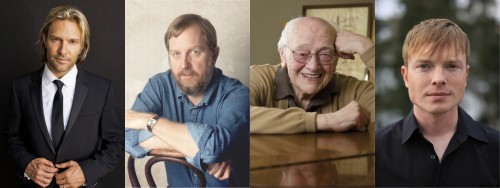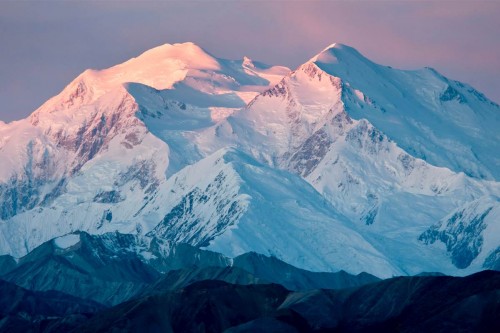
The EWO concert’s four composers: Eric Whitacre, Joseph Schwantner, Karel Husa, John Mackey
By Eric Laprade
The Eastman Wind Orchestra, under the direction of Professor Mark Davis Scatterday, will present its second concert of the spring semester tonight, Monday, February 22, 2016, at 8 p.m. in Kodak Hall at Eastman Theatre. The concert is free and open to the public.
The repertoire on the program was composed between 1975 and 2013 — works that are considered relatively new for the wind ensemble. While two of the works are absolute in their construction — the Whitacre and Schwantner — the Husa and Mackey evoke vivid imagery with inspiration from both art and nature.
Although the compositions vary greatly in their construction, style and inspiration, all of the composers on the program share a unique connection to New York State. Joseph Schwantner served as a faculty member of the Eastman School of Music from 1970 to 2001. Born and educated in Prague, with further studies in Paris, Karel Husa moved to the United States in 1954 to serve on the faculty of Cornell University, a position that he held until 1992. Both John Mackey and Eric Whitacre were students at the Juilliard School in New York City, where they studied with John Corigliano.
The concert will open with Whitacre’s Equus. Composed between 1997 and 2000, the work was commissioned and premiered by the University of Miami Wind Ensemble, under the direction of Gary Green. The work is minimalist in nature, with much of the melodic and rhythmic material derived from a single idea. Whitacre describes his inspiration:
I wanted to write a moto perpetuo, a piece that starts running and never stops—equus is the Latin word for horse—and would also be a virtuosic show piece for winds. The final result is something that I call “dynamic minimalism,” which basically means that I love to employ repetitive patterns as long as they don’t get boring.
Joseph Schwantner, recipient of the prestigious Pulitzer Prize in music, composed Recoil for a commission from the Raymond and Beverly Sackler New Music Foundation of the University of Connecticut. The work is significant within Schwantner’s oeuvre in that it is his first work for wind ensemble to include both saxophone and euphonium. The composer writes:
Recoil is my fourth work for wind ensemble in a series of pieces that span twenty-nine years. The other works are: …and the mountains rising nowhere (1977), From a Dark Millennium (1980), and In evening’s stillness (1996). While Recoil employs a larger instrumentation than the earlier works, they all share similar characteristics in that each is framed in a single continuous movement and each exploits the rich timbral resources of an expanded percussion section that includes amplified piano.
The second Pulitzer Prize winning composer on the program, Karel Husa, composed Al Fresco for the Ithaca College Concert Band as the first work in the Walter Beeler Memorial Commission Series. Much of Husa’s inspiration for the work came from the time he spent studying in Paris:
Al Fresco has no programmatic content. However, the title indicates my admiration for the art of painting, especially mural painting on wet plaster. I was always interested in tonal colors and greatly admired the work of Mussorgsky, Bartók, and Ravel. My study with Arthur Honegger also greatly influenced my sense of tonal color. And I have always been greatly moved by the forceful, even grandiose and rough, mysterious pictures dealing with primitive life, war, and pageantry.

Alaska’s Mt. McKinley (given its original Native American name of Denali in 2015)
The concert will close with the most recently composed work: John Mackey’s epic The Frozen Cathedral. Premiered in 2013, the work takes inspiration from Alaska’s Mount McKinley. Measured from its base to its peak, “Denali” is the tallest mountain in the world. Commissioned by John Locke and the University of North Carolina at Greensboro, Mackey composed The Frozen Cathedral in honor of Locke’s son, who passed away unexpectedly and had a love for and fascination with the Alaskan wilderness.
The Frozen Cathedral is scored for an expanded wind ensemble, including alto flute, bass flute, celeste, and harp. The percussion orchestration is equally diverse, scored for 10 performers, featuring antiphonal instruments surrounding the audience and calling for such unique instruments as the waterphone and pitched crystal glasses. Mackey’s orchestration is highlighted through a beautiful bass flute solo, which is both haunting and optimistic. In many regards the work represents the evolution of grief one experiences when confronted with the greatest of losses: the loss of a child. What begins as cold, full of despair, dark and empty, slowly heals through the duration of the work, with the same musical material reappearing in the latter half with a new sense of hope, light, warmth and optimism.
The Eastman Wind Orchestra
Mark Davis Scatterday conductor
Kevin Holzman and Eric Laprade, assistant conductors
Monday, February 22 2016
8:00pm
Kodak Hall at Eastman Theatre
Free and open to the public